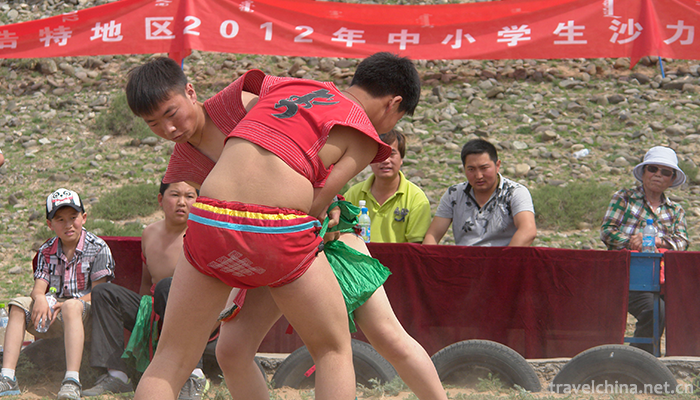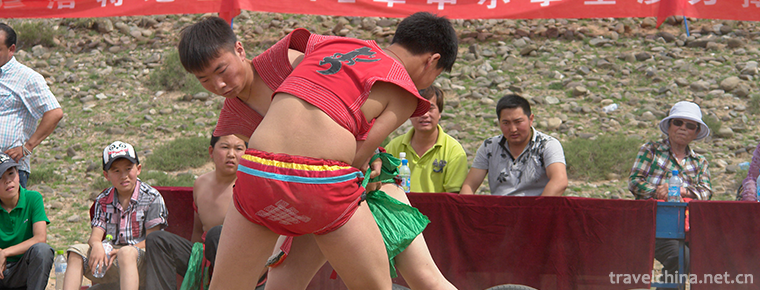Sharipol wrestling
Sharipol wrestling
Shaliboer style wrestling is a national traditional sports event originally created and retained by the Weilat Mongolian people. It is one of the main sports events in the Uznada Mu Grand Event in Alashan. The word "Shaliboer" derives from the Mongolian words "Shalaba" (rapid meaning) and "Shalamagai" (agile), and has evolved into "Shaliboer" after a long period of phonetic translation. The action of cutting shovel, knee folding and grasping collar in Shalibol wrestling is named after the action of camel fighting. Shaliboer-style wrestling alliances, Sumu towns and parts of Mongolian settlements in Xinjiang, Qinghai and Gansu are popular.
On June 7, 2008, Shaliboer wrestling was listed in the second batch of national intangible cultural heritage list with the approval of the State Council.
Brief Introduction to Wrestling
In June 2008, it was selected as the second batch of national intangible cultural heritage list approved by the Ministry of Culture by the State Council.
Declaration: Alashan Left Banner of Inner Mongolia Autonomous Region
In Alashan, western Inner Mongolia, there is also a Mongolian Wrestling - "Shaliboer". You can see the picture of the Mongolian Shaliboer.
Shaliboer wrestling is a traditional national sport originated and retained by Alashan Heshuote Mongolian people, and it is also one of the main sports events in Alashan's ancient "Uzbekistan" Festival and modern Nadam congress.
After a long period of phonetic translation, it has evolved into the word "Sarabauer". The action of cutting shovel, knee folding and grasping collar in Shalibol wrestling is named after the action characteristics of camels fighting against each other. The number of participants in Sharipol wrestling must be a multiplier of 2, regardless of body weight level, and a wrestling will be the winner or loser. In the competition, barefoot wearing triangle shorts head-on from the two corners of the court, grabbing each other's shorts and then starting to attack.
Shaliboer wrestling skills include: forward attack, fierce back, sneak attack, backward push, left pull and right twist, inside and outside foot grabbing, rotating pressure, up pressure, air spin, singles, shoulder loosening, hard resistance, up and down buckle, etc. Athletes need to have strong physique, endurance, wisdom and skills.
The Origin of Wrestling
Shalibol wrestling is a traditional national sport originated and retained by the Mongolian people of Alashan and Shuote. It is also one of the main events in the ancient "Uzbekistan" Festival and the modern Nadam festival in Alashan. The word "Shaliboer" derives from the Mongolian words "Shalaba" (rapid meaning) and "Shalamagai" (agile), and has evolved into "Shaliboer" after a long period of phonetic translation. The action of cutting shovel, knee folding and grasping collar in Shalibol wrestling is named after the action of camel fighting.
Shaliboer wrestling has many skills regardless of body weight. Athletes need to have strong physique, endurance, wisdom and skills. Sharipol wrestling is not restricted by sex, age, venue, time and clothing. The champion who wins the Uzhis event can receive nine prizes such as sheep and the title of "sacred wrestler".
Wrestling Inheritance
Shaliboer wrestling is a popular activity, which has been passed down among the local Mongolian people for more than 300 years. For various reasons, this traditional project has faced the situation of losing its heritage. Since May 2004, Alashan Left Banner has organized manpower to go deep into all parts of the banner and to Qinghai, Xinjiang and other places to excavate and organize this traditional form of sports activities, formulate rules and clothing, train 56 referees and 56 coaches from all parts of the region, and carry out the national "Shaliboer Cup" Boke Competition. At the beginning of this year, the People's Committee of Inner Mongolia Autonomous Region and the Sports Bureau decided to list the Shaliboer wrestling as a competition item of the regional people's games.


-
1.Alice tomato noodles
The Ali brand was born in 2001 and officially launched in 2005. The brand popularity and honor of Ali Juice Noodle series products are constantly improving
Time 2018-11-26 -
2.Qin Lake National Wetland Park
Qinhu National Wetland Park is located between the central part of Jiangsu Province and the Yangtze and Huaihe River.
Time 2018-12-06 -
3.Chengji Mountain Tourist Scenic Spot
Qiu Mountain, also known as Linglong Mountain, Xianshan Mountain on a journey to the West and Qiu Mountain Scenic Area, is located in Suiping County, Zhumadian City, Henan Province
Time 2018-12-09 -
4.Hepeishan National Forest Park
Hepeishan National Forest Park is located in Zouping County, Binzhou City, Shandong Province, at the junction of Zouping County and Zhangqiu County. The total area of the park is 480 hectares
Time 2019-01-13 -
5.Lingnan Impression
Lingnan Impression Park is located in the south of Guangzhou University Town (Xiaoguwei Island). It covers an area of 16.5 hectares. It is a tourist attraction that gathers sightseeing
Time 2019-02-03 -
6.Cham
The Yi epic, recorded in the old Yi language and widely circulated, describes the origin of all things in the Yi legend. The Yi people call it a "search" to describe the origin of a thing be
Time 2019-04-15 -
7.the Wu Ballads
Wuge is the oral literary creation of the majority of the people in Wu dialect area, which originated in southeastern Jiangsu Province, and Suzhou is the central area for the generation and developmen
Time 2019-06-29 -
8.Da Yu
Yu, surnamed Si, is famous for his life. (Yu Yu is the name). History is called Da Yu and Emperor Yu. Xia Hou Shi Chieftain Xia Dynasty The founding king. Yu is Yellow Emperor Great grandson, Zhuan Gr
Time 2019-09-07 -
9.Four famous Chinese embroidery
Suzhou embroidery is famous for its fine stitches, elegant colors and fine embroidery. It has the characteristics of flat, light, even, harmonious, fine and dense. The theme is mainly about small animals. Such as "cat play", "wind through flowers",
Time 2020-12-12 -
10.Guangyuan primary industry
In 2018, the annual grain sown area in Guangyuan City was 311300 hectares, down 0.5% from the previous year. The total grain output was 1.5641 million tons, down 0.4%. Among them, the grain output in spring decreased by 0.7% to 384900 tons, and that
Time 2020-12-15 -
11.Plant resources in Neijiang
Neijiang City is a subtropical evergreen broad-leaved forest belt with mild climate and abundant rainfall, which is suitable for the growth of a variety of trees. There are more than 60 subjects, 110 genera and 190 species. Neijiang is mainly composed of timber forest
Time 2020-12-16 -
12.Dazhou social security
In 2019, the per capita disposable income of Dazhou residents is 22995 yuan, an increase of 10.1%. The per capita disposable income of urban residents was 33823 yuan, an increase of 9.5%. Among them, salary income was 18783 yuan, an increa
Time 2020-12-20